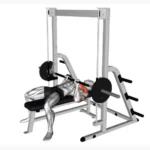Dumbbell Squat Overview
The dumbbell squat is a fundamental exercise for strengthening the lower body, targeting the quadriceps, glutes, hamstrings, and core. This versatile movement builds muscle, enhances stability, and improves functional fitness for daily activities like lifting or climbing stairs. Unlike barbell squats, dumbbell squats allow for greater freedom of movement and are easier to perform at home or in gyms with limited equipment. Variations such as goblet squats (holding one dumbbell at chest level), front-racked squats (dumbbells at shoulders), or sumo squats (wide stance) offer flexibility to suit different fitness levels and goals. Ideal for beginners and advanced lifters alike, dumbbell squats promote joint health, boost calorie burn, and support overall strength development. Add them to lower-body workouts, full-body routines, or strength circuits for a powerful leg-building exercise.
Dumbbell Squat Instructions
- Select Dumbbells: Choose a pair of dumbbells with a weight that challenges you but allows proper form. Beginners should start light to focus on technique.
- Position Your Body: Stand with feet shoulder-width apart, toes slightly turned out (about 10-15 degrees) for balance. Hold a dumbbell in each hand, either by your sides (palms facing inward) or at shoulder height (front-racked position).
- Engage Your Core: Brace your abdominal muscles, keep your chest lifted, and maintain a neutral spine with shoulders retracted to prepare for the movement.
- Initiate the Squat: Push your hips back as if sitting into a chair, then bend your knees to lower your body. Keep your weight centered over your midfoot.
- Lower to Depth: Descend until your thighs are at least parallel to the ground or as low as your mobility allows, ensuring your knees stay aligned with your toes.
- Rise to Standing: Drive through your heels to stand back up, squeezing your glutes at the top to fully extend your hips. Avoid locking your knees.
- Repeat: Perform 3 sets of 8-12 reps, resting 60-90 seconds between sets. Focus on controlled, fluid movements for maximum effectiveness.
Dumbbell Squat Tips
- Perfect Your Form: Start with bodyweight squats or light dumbbells to master technique before increasing weight to prevent injury.
- Core Stability: Keep your abs engaged throughout to support your spine and maintain balance, especially during deeper squats.
- Heel Drive: Push through your heels, not your toes, to activate your glutes and hamstrings and reduce knee strain.
- Knee Alignment: Ensure your knees track over your toes and don’t collapse inward to protect your joints.
- Breathing Technique: Inhale as you lower into the squat and exhale as you stand up to maintain core pressure and rhythm.
- Variation Options: Try goblet squats (holding one dumbbell at chest level) or sumo squats (wide stance) to target different muscle groups or improve comfort.
- Posture Check: Keep your chest up and avoid rounding your back or leaning too far forward to maintain a neutral spine.
- Progress Gradually: Increase weight or reps over time as strength improves, but prioritize form to avoid compromising safety.
Benefits: Dumbbell squats build stronger quads, glutes, and hamstrings, improve core stability, and enhance joint mobility. They also boost functional strength for everyday movements and increase calorie burn for fat loss.
Building quads and glutes with dumbbell squats? Explore how they fit into our Ultimate Guide to Muscle Groupsfor leg strength.






